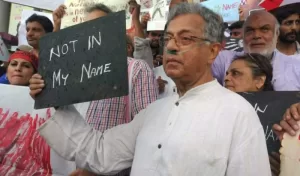Some years ago when I became a senior citizen, I received a generous invitation from the Delhi government to visit Hindu pilgrimage sites across the country at their expense. It was a lavish itinerary that included a range of temple towns in southern and western India, as well as the northern Char Dham (at the age of 60, the government presumes people stop visiting malls and turn to God). I thanked the minister who had issued the invitation, but declined, asking if instead he would fund my trip to some Christian and Muslim sites that I had not visited, rather than revisit already familiar places. I didn’t hear from him again.
The active promotion of Hindu places of pilgrimage is today being done on public budgets. At a time of critical medical emergency, the government continues to spend funds on religious projects. Four-lane highways are in construction at a cost of Rs 12,000 crore to connect the Char Dhams; Rs 800 crore is being spent on the Kasi-Vishwanath corridor upgrade.
But what of other religious sites? Is there any attempt to ease movement in crowded Muslim places of worship, or to connect ancient Buddhist centres of learning? The Dargah at Ajmer requires a serious rethink and redesign of approaches and entrances. Similar problems exist in the many inaccessible monasteries of Sikkim and Arunachal Pradesh. Other than those on World Heritage lists, many Goan cathedrals are in dire need of structural repair. But it is unlikely that the government will shell out any money for their upkeep. The Dargah at Nizamuddin had to rely on the Aga Khan Foundation’s support for creating basic services inside the Delhi precinct.
The most recent Hindu project involves the investigation and reestablishment of the ancient river Saraswati, the underground riverbed in north-west India that has suddenly appeared as a promising geological smudge on the Hindu map, and is causing great excitement. The government wasted no time in setting up the Rs 6-crore Center of Excellence for Research on the Saraswati River (CERSR) at Kurukshetra University. The Haryana government then approved another Rs 600 crore for several other related projects. Frittering away vast amounts on myth and hope does little to help the large numbers of local farmers living on the brink of starvation and struggling to pay off small bank loans, or the many rural families ravaged by COVID-19.
But, who cares.
Mythology is the new mantra. So convincing is the prospect of the waterway’s bountiful revival that local farmers have already begun to believe that their sparse wells are being fed by the ancient river, and its waters are helping to cure the high incidences of cancer prevailing there. In order to give credence to the theory, a Rs 120-crore Saraswati Heritage Development Board has been set up by the government.
A smart move. Science after all is slow, tedious and evidence riddled, while mythology provides quick and immediate results. Whenever some politician presents proof of Indian advancement in myth and history, be it the plastic surgery that grafted Lord Ganesha’s trunk, or ancient flying machines that used donkey’s urine for fuel, Indian scientists are quick to oppose the sham evidence. Even if a dry water channel is found in the Adi Badri belt in Haryana, they maintain, there is little proof that it belongs to the ancient river. Besides, recent ethnological studies point out that the Indus Valley culture that grew in the area was most likely of mixed African and Central Asian origins, rather than Aryan descent, an idea that may not go down so well with the ultra-nationalists who support the Saraswati’s revival.
In the past several years there have been so many instances where Hindu myths are vehemently supported by some politicians, it is hard to tell whether these are out of genuine historical inquiry, or a mindless support of all things Hindu. Stories oscillate between the half-baked and the ridiculous. A BJP MLA from UP has demanded the renaming of the Taj Mahal to Ram Mahal, stating that the temple to Lord Shiva has been erroneously called a Mughal shrine for the last four centuries. Hindu influences on the design of Akbar’s tomb at Sikandra have prompted some to suggest that it too was a temple. Other questions remain: Did the ancient Aryan migrations use the old route of the Grand Trunk Road when they entered the Khyber Pass? Was the Bandra-Worli Sea Link originally used as a mythical overpass for transporting Shivaji’s army? The Saraswati’s river hydrology will need some solid physical proof if it is to become a serious contender for Hindu culture.
It hardly needs stating that when the pandemic hit last year, most countries diverted all their efforts to its quickest resolution. After Donald Trump’s misguided attempt, US President Joe Biden stopped the construction of the southern border wall, so federal funds could be made available for medical relief; New York City’s upgrades of bridges, tunnels and highways were suspended. West African countries like the Congo and Mali redirected budgets meant for road improvement into public hygiene and rural clinics. To stop useless inessential expenditure at a critical time is not the mark of a courageous government, only a just one.
(Gautam Bhatia is a Delhi-based architect and sculptor. Courtesy: The Wire.)




